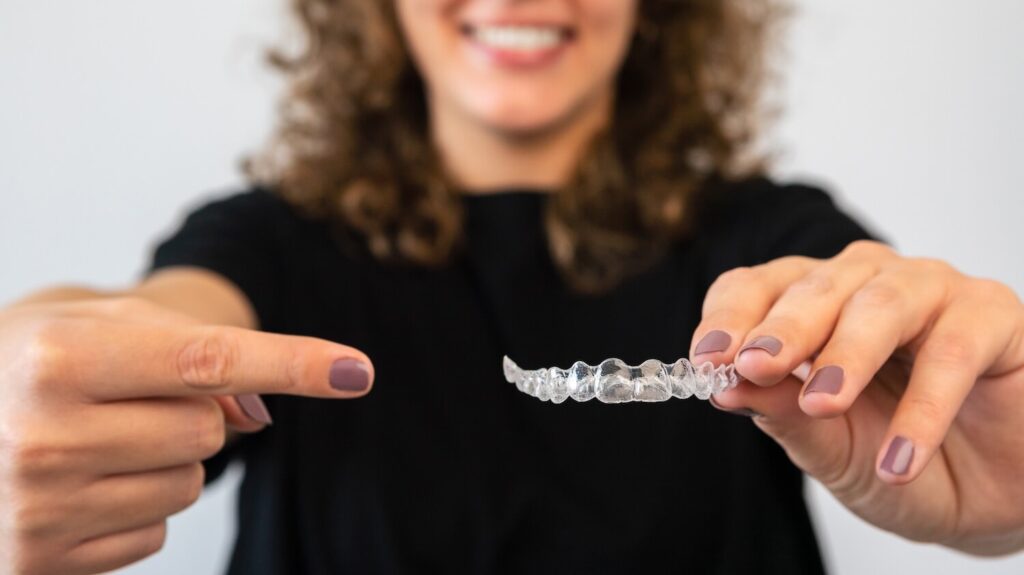Invisalign, a modern solution to straighten teeth, has grown in popularity over the years as an alternative to traditional metal braces. The appeal is clear—Invisalign offers the opportunity for a discreet, comfortable, and effective way to achieve a beautiful, straight smile without the noticeable brackets and wires associated with conventional braces. However, the question many prospective patients ask is, “How much does Invisalign cost, and is it worth the investment?”
In this comprehensive guide, we will break down the costs associated with Invisalign treatment, including factors that influence the price, what is included in the cost, financing options, and most importantly—whether the benefits justify the price tag.
Whether you’re considering Invisalign for aesthetic reasons, to correct bite issues, or to simply improve the function of your teeth, this article will help you navigate the investment required to achieve the smile of your dreams.
What Is Invisalign?
Invisalign is a brand of clear, custom-made aligners that gradually shift your teeth into the desired position. These aligners are made from a patented, BPA-free plastic material that is virtually invisible, which makes them an attractive option for those who want to avoid the visibility of traditional braces.
The treatment works by using a series of aligners, each one slightly different from the last. Every two weeks, you replace your current aligner with the next in the series, slowly and steadily moving your teeth. Treatment can take anywhere from 12 to 18 months, depending on the complexity of your case, and aligners should be worn for at least 22 hours a day to achieve the best results. The fact that Invisalign is removable also makes it easier to maintain good oral hygiene and enjoy food without restrictions.
Factors That Influence the Cost of Invisalign
The cost of Invisalign is often a concern for many individuals considering orthodontic treatment. The price can vary significantly depending on a variety of factors. Here’s a deeper dive into these key elements:
1. Treatment Complexity and price
The complexity of your orthodontic needs is one of the biggest determining factors when it comes to the cost of Invisalign. If your teeth are only slightly misaligned, your treatment may be straightforward and less expensive. However, more complicated cases—such as severe crowding, overbites, underbites, or significant gaps between teeth—require more advanced and custom treatment plans, which can increase the cost.
For minor cases, Invisalign treatment can start around $3,000 to $4,000, while more complex cases may cost $6,000 to $8,000 or even higher. Some patients might require additional interventions such as attachments or the use of rubber bands, further impacting the overall price.
2. Geographic Location
The location of your orthodontist also plays a significant role in the price of Invisalign treatment. In large metropolitan cities, where the cost of living is higher, you may find that Invisalign treatment is more expensive. Conversely, in smaller towns or rural areas, the price might be lower due to lower overhead costs and less competition among providers. This can be an important consideration when budgeting for Invisalign treatment.
In general, the cost of Invisalign treatment in the United States can range from $3,500 to $8,500, depending on the location.
3. The Experience and Reputation of the Orthodontist
Orthodontists with more experience and specialized training in Invisalign treatment may charge higher fees due to their advanced skills and expertise. Highly skilled orthodontists are able to tackle complex cases and achieve optimal results, which can justify a higher treatment cost.
Choosing a reputable and experienced provider is essential for ensuring that your treatment is effective, safe, and tailored to your specific needs. While price may be a consideration, the quality of care should be paramount.
4. Additional Treatments or Procedures
Sometimes, Invisalign treatment alone may not be sufficient to correct certain dental issues. If you have a complex case, your orthodontist may recommend supplementary treatments such as tooth extractions, dental bonding, or enamel contouring. These additional treatments can increase the cost of your Invisalign treatment. In some cases, you may also need attachments (small, tooth-colored bumps attached to the teeth to help move them more efficiently), which will add to the overall cost.
What’s Included in the Cost of Invisalign?
When calculating the cost of Invisalign, it’s important to know what exactly is included in the price. Most providers include the following in their Invisalign package:
- Initial Consultation and Assessment: The first step in the Invisalign process is an initial consultation where your orthodontist will examine your teeth, take X-rays, and possibly create impressions or digital scans. This also includes a discussion of your treatment goals and an evaluation of your oral health to determine if Invisalign is the right option for you.
- Custom Aligners: The custom clear aligners are the main product of the treatment, and their production is included in the overall cost. The aligners are made from advanced materials to ensure comfort, durability, and effectiveness.
- Follow-up Visits: Invisalign requires regular check-ins with your orthodontist, typically every 6-8 weeks, to monitor progress and ensure the treatment is working as planned. These visits are usually included in the overall cost, but it’s important to verify this with your provider.
- Retainers: After your Invisalign treatment is complete, retainers will be necessary to maintain the new position of your teeth. In some cases, the cost of retainers is included in the price of Invisalign. However, in other instances, they may be an additional charge. Retainers are crucial for ensuring that your teeth don’t shift back to their original positions.
What’s Not Included?
- Additional Treatments: If your treatment plan requires supplementary dental work like extractions or dental bonding, these services may incur additional fees. For example, some patients may need to have wisdom teeth removed before beginning Invisalign.
- Lost or Damaged Aligners: Invisalign aligners are designed to be durable, but if you lose or damage one, you may need to purchase a replacement at an extra cost.
It’s essential to confirm with your orthodontist what is included in the price and what may incur additional charges before starting treatment.
Invisalign Payment Options and Financing
Understanding the cost of Invisalign treatment is just one part of the equation; how you’ll pay for it is the next consideration. Fortunately, there are several options available to help manage the cost of Invisalign:
1. Dental Insurance
Many dental insurance plans cover a portion of the cost of orthodontic treatment, including Invisalign. However, it’s important to understand that not all insurance policies cover Invisalign, and some plans have specific limitations or restrictions on coverage. Most plans will cover a percentage of the total cost, and the rest will need to be paid out-of-pocket.
In some cases, your insurance may provide coverage for traditional braces but exclude coverage for Invisalign. It’s essential to contact your insurance provider to check your benefits and find out if Invisalign is covered, as well as any limitations or co-pays that may apply.
2. Flexible Invisalign Payment Plans
Many orthodontists offer flexible payment options to help manage the cost of Invisalign. These plans allow patients to spread the total cost of treatment over a set period, typically with monthly payments. Payment plans can be customized to fit your budget, making it easier to afford treatment.
In most cases, these plans can range from $100 to $300 per month, depending on the length of your treatment and the overall cost of your plan. Some providers also offer interest-free or low-interest financing.
3. Health Savings Accounts (HSAs) and Flexible Spending Accounts (FSAs)
If you have an HSA or FSA, you can use the funds in these accounts to pay for Invisalign treatment. HSAs and FSAs allow you to set aside pre-tax dollars for medical expenses, including orthodontic treatments. This can reduce your overall tax liability and make the cost of Invisalign more affordable.
4. Third-Party Financing
Many orthodontists partner with third-party financing companies, such as CareCredit, that offer low-interest or no-interest payment plans. These financing options can make the cost of Invisalign more manageable, allowing you to pay in installments over several months or years.
5. Discounts for Upfront Payments
Some orthodontists offer discounts for patients who pay the full cost of treatment upfront. If you have the financial flexibility, this option can save you a significant amount on the overall cost.
Why Invisalign is Worth the Investment
While Invisalign can be expensive, many people find it to be a worthwhile investment. Here’s why:
1. Aesthetic Appeal
The biggest draw for many people is Invisalign’s aesthetic appeal. The clear aligners are virtually invisible, making them ideal for people who want to straighten their teeth without the noticeable appearance of traditional metal braces. For adults or teens who may feel self-conscious about wearing visible braces, Invisalign offers a discreet solution that allows them to smile with confidence throughout the treatment process.
2. Improved Oral Hygiene
One of the challenges of wearing traditional braces is that brushing and flossing can be difficult due to the wires and brackets. With Invisalign, the aligners are removable, meaning you can take them out to brush, floss, and clean your teeth thoroughly. This results in better oral hygiene and a lower risk of tooth decay, gum disease, and other dental issues during treatment.
3. Comfort and Convenience
Invisalign aligners are made from smooth plastic that is more comfortable than traditional braces, which often cause irritation to the gums and mouth. Additionally, since Invisalign aligners are removable, there are fewer restrictions on the foods you can eat. You can continue to enjoy your favorite foods without worrying about damaging braces.
4. Faster Results
In many cases, Invisalign treatment can deliver faster results than traditional braces. While the length of treatment depends on the complexity of the case, some patients experience noticeable improvements in just a few months. Since the aligners are designed to make gradual adjustments, treatment is often quicker and more comfortable than other methods.
5. Better Long-Term Dental Health
Straightening your teeth is not just about improving appearance; it’s also about improving the function of your teeth. Misaligned teeth can lead to difficulties with chewing, speaking, and even breathing. Moreover, misaligned teeth are harder to clean, which can increase the risk of cavities and gum disease. By addressing these issues with Invisalign, you’re improving your long-term dental health.
Conclusion
Invisalign can be a significant investment, but for many people, the benefits far outweigh the costs. From the cosmetic advantages to the improvements in oral health, Invisalign offers a clear path to a beautiful smile. The total cost of Invisalign treatment varies depending on several factors, including treatment complexity, location, and your provider’s experience. However, financing options and insurance coverage can help make the treatment more affordable.
Ultimately, the decision to pursue Invisalign treatment should be based on your unique needs and goals. With its comfort, convenience, and cosmetic benefits, Invisalign provides an attractive option for those seeking to enhance their smile without the drawbacks of traditional braces. When you consider the lifelong benefits of a healthy, beautiful smile, Invisalign can indeed be a valuable investment in both your appearance and your well-being.


